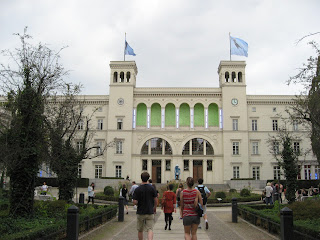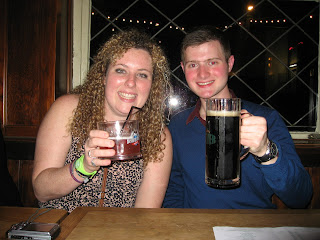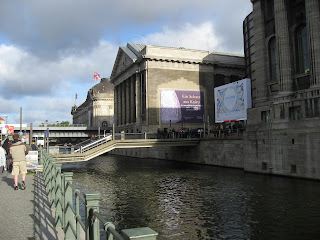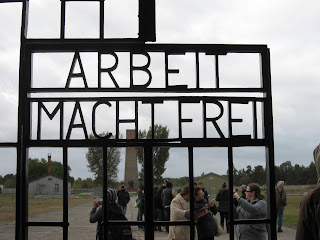For the European Memory & Identity long study tour, we went to Berlin for a week (the course's France section went to Paris and the Czech Republic section went to Prague). We flew EasyJet, a budget airline located all the way at the end of the terminal at Copenhagen Airport. The flight takes less than 45 minutes.
 |
| The EasyJet terminal in Copenhagen is eerily empty. |
Berlin is much bigger than Copenhagen (it is about the size of Philadelphia), much cheaper, much more lively, and frankly, has much more history and culture.
 |
| Leonid Brezhnev smooches with Erich Honecker on a segment of the Berlin Wall between Schönefeld Lufthafen and Prenzlauerberg. |
Our hostel, the Pfefferbett, is in a former brewery in Prenzlauerberg, a gentrified neighborhood in East Berlin. I share a room with five other students. There is a free breakfast every morning, and the lobby has foozball, a pool table, a projector, and a bar that also serves meals. They play good music in the lobby; it starts out mellow in the morning and gets wilder and louder as the day progresses.
Here's our neighborhood.
 |
| Whenever I feel that America is losing its place in the world, I see a reminder that our empire is still strong. |
 |
| After the fall of the Wall, a local artist decided to liven up the crappy Socialist architecture by putting these little guys on the traffic lights. |
 |
| Döner at a Turkish restaurant. |
I have to give an oral presentation on the Alexanderplatz. My presentation is the first of the trip, and my partner fell ill and couldn't come with us, so I am a little bit nervous. The Alex was an ox market for centuries, and after a visit by Russian Tsar Alexander I in 1805, it was given its current name. In the latter half of the 19th century, it became one of Berlin's many nexuses of transportation, commerce, and social life (read Alfred Doblin's Berlin Alexanderplatz to get a sense of this hustle and bustle in the context of the 1920s Weimar Republic). The Alex was leveled during the war and rebuilt by the GDR in the early '50s as a model of Socialist architecture and planning. The wide boulevards on both sides of the square isolated it from pedestrian life, and it never quite regained its metropolitan feel. The Alex was given a minor facelift in the late '60s, and another in the early '90s. It retains much of its Socialist feel, but a major redevelopment is slated for the coming decades. So take a look at these photos -- what you see may not be around for much longer.
 |
| East Berlin. The buildings in the distance were built by the Communists after the war. They are somewhat nicer than the ones nearest to me, as they were constructed before the German Democratic Republic realized it had no money to continue building them in that way. |
 |
| Me talking to the group about the Alex. |
 |
| Reminders of Socialist artwork |
 |
| The World Clock in the Alex, built in the late '60s by the GDR. Certain cities, such as Jerusalem, were omitted for political reasons. |
 |
| The GDR built this television tower in the late 1960s. Ironically, the reflection of the sun causes a giant crucifix to shine across its sphere. It is lovingly called the "Telespargel" (Tele-Asparagus); funnily enough it was very hard to get asparagus in the GDR. It now houses a restaurant, the Telecafé, but continues to serve as a broadcasting tower. |
Continuing on our walking tour:
 |
| Statue of Marx and Engels, moved into a corner of a park after the Wall fell. There were many tourists from China and Vietnam taking photos with the founders of Communism. |
 |
| The Prussian Palace was torn down by the Communists after World War II. Ruins of the basement are all that remain. The palace is being excavated and rebuilt as a cultural center and museum. |
 |
| A museum and restaurant, where you can eat and learn as you watch the Prussian Palace being rebuilt. |
 |
| Museum Island |
 |
| A memorial to Communist Jewish resistance fighters who in 1941 set fire to a Nazi exhibit demonizing the Soviet Union. |
 |
| The river Spree |
 |
| This art museum has all the adornments of an imperial palace on the exterior, but the architect installed death masks on the inside to remind visitors of the horrors of war. |
 |
| The Guard House, once a jail, now houses a memorial to victims of the war. |
 |
| The memorial in the Guard House is controversial because it memorializes the German dead as a whole, rather than just those who were persecuted by the Nazis. |
 |
| Frederick the Great |
 |
| Humboldt University. Outside the gates are "stumbling blocks," little plaques in the ground that memorialize Jewish students who perished during the Holocaust. Stumbling blocks can be found all over Berlin. |
 |
| The Gendarmarkt |
 |
| Thorsten leading a tour of historical buildings and offices near the Gendarmarkt |
 |
| The Greek embassy. I'm surprised by the lack of rotten eggs splattered against the facade. |
 |
| There are little pictures of bananas all over Berlin. They became a symbol of Communist deprivation -- everyone in East Berlin wanted to eat one, but couldn't get one. |
 |
| Berlin is a city that is always rebuilding itself. |
 |
| The Russian (formerly Soviet) embassy. |
 |
| Blowing bubbles at the Brandenburg Gate. Today is the 21st anniversary of reunification, and there's a big festival at the Gate. |
 |
| The Hotel Adlon, where Bernie Gunther was the house detective in Philip Kerr's Berlin Noir novels. |
 |
| In true West German fashion, there was an abundance of free Coca-Cola being handed out at the festival. |
At sunset, we visit the Memorial to the Murdered Jews of Europe. The design is meant to be both unsettling and a part of everyday life: people use it as a shortcut to get to work, and children play on it. But you can't pass through it without being reminded of being in a very dark and lonely place.
Our first night in Berlin:
 |
| A bar in Prenzlauerberg |
 |
| In Berlin, you can get cocktails to go, in smoothie cups. And you can drink them on the street. |
Day 2:
 |
| Willy Wonka? |
 |
| The Berlin Wall memorial park. The wall's deterrents included guard towers, canine patrols, vehicle tracks, mine fields, trip-wire guns, spikes in the ground, silent alarms, and little holes in the wall that bunnies could go through so that they wouldn't be obliterated. |
 |
| Me, trying to escape over the wall to freedom. As it turns out, I was actually climbing toward the West, which I should have figured out from the lack of graffiti on this side. |
 |
| Those who died trying to escape to the West. Note the small children and the East German policeman. |
 |
| The "Palace of Tears," where Western visitors said goodbye to their friends and family in the East. |
 |
| "Trains to Life, Trains to Death," memorializing those German Jewish children who perished in the Holocaust and those who were saved by British orphanages between Kristallnacht and the outbreak of the war. |
Now we move into the government district.
 |
| Many German legislators have their offices here. |
 |
| The Reichstag |
 |
| Lunch atop the Reichstag. How eerie it is to eat the same strudel recipe that the Kaiser might have eaten! |
 |
| Berlin Hauptbanhof (central station) |
 |
| This modern art museum used to be a transportation museum, and before that, it was a train station that serviced the Hamburg-Berlin route. |
 |
| Andy Warhol |
 |
| Cloud Cities |
 |
| Roth |
 |
| We spent the rest of the night at a Biergarten. The size of my drink is directly proportional to the amount of ground that I covered. |
Day 3
Potsdamer Platz
 |
| Gum covering a section of the Wall |
 |
| Unlike many parts of Berlin, Potsdamer Platz has been subjected to total redevelopment. There are few reminders of war, whether hot or cold, here. |
The "Topography of Terror": the seat of the Nazi administration
 |
| This structure is still pockmarked by bullet holes. |
 |
| The Nazi Ministry of Aviation, now the Finance Ministry. |
Checkpoint Charlie:
 |
| An American soldier looks into the Soviet Zone. It turns out that this particular GI was a trumpet player in an Army band. |
The Jewish Museum:
 |
| The Garden of Exile |
 |
| A "memory void" |
A local mosque:
 |
| This mosque, near Tempelhof Airport (now Tempelhof Park), serves the large Turkish minority. Many Turks were brought over as guest workers after the war and stayed in Germany. Germany remains a major destination for Turkish emigrants. |
 |
| The tall fellow with the glasses, Uffuq, gave us a tour of the mosque. He works as a docent at the Jewish Museum. |
 |
| Pickled fruits and vegetables at a Turkish restaurant. |
Day 4
The "Jewish Quarter"
 |
| This memorial commemorates the imprisonment of Jewish men in mixed marriages by the Gestapo in 1943. The prisoners' wives protested for days outside the Gestapo prison. The Gestapo had no idea how to respond to the situation. On this rare occasion, the men were released and survived the war. |
 |
| This man ranks 4th in the world in the Kaiser Wilhelm category for mustache competitions. He is the caretaker of Otto Weit's Workshop for the Blind. Weit saved a number of handicapped Jews by employing them in his brush factory. Weit's factory is now a small museum. |
 |
| "Never trust the green lawns in Berlin." This Jewish cemetery was plucked of its headstones and turned into a soccer field and air raid shelter during the war. It is once again restored and home to a memorial. |
 |
| Inside the restored synagogue in Berlin (it was turned into a uniform warehouse during the war). |
 |
| Photography Museum, with a special exhibit on terrorism |
 |
| The KW art gallery in the Jewish quarter. That isn't head hair. |
 |
| Pittsburgh Steelers? |
 |
| A "Little Lucy" |
This is a park where many artists have their studios. Visitors are welcome to just sit down on a couch and watch the artists work.
 |
| Meow |
 |
| If it survives the minefield, this cat stands to enjoy better milk and fatter mice in the West |
|
Back to the Gendarmarkt for dinner before a concert.
 |
| At the Ritter chocolatier. I ate a giant marzipan chocolate bar for dinner that night. |
 |
| Cognac Cowboy |
 |
| "Surprise Symphony" at the Konzerthalle, with an amazing violin solo. |
Day 5
Today we are off to Potsdam. It's about a 45-minute drive. The first stop is Sans-Souci, Frederick the Great's summer pad.
 |
| Frederick the Great built Sans Souci ("Without Worries) in Potsdam as his summer palace. Frederick's friend Voltaire once refused to have a sleepover here, so Frederick put him under house arrest and made him. |
Now we go to a more sinister destination.
 |
| Wannsee Villa. Leaders of the Third Reich met here in 1941 to devise the Final Solution. It was bought by the SS as a conference center and guest house, and Reinhardt Heydrich planned to turn it into his home after the war. It served as a retreat for West German schoolchildren after the war and is now a Holocaust museum with a focus on the infamous Wannsee Conference. |
Heading back toward Berlin...
 |
| A memorial to Jews who were deported by train at the rail station in Berlin's Bavarian Quarter. |
It has been a great trip. I feel that I learn more history each day here than I have learned in an entire month and a half in Copenhagen. But sadly, our adventure must come to an end. After all, I am supposed to be studying in Denmark. But it is our last night in Berlin, so it would be a crime not to go out with a bang.
 |
| And by bang, I mean hitting up this place before going bar crawling until 4 a.m. |
 |
| Erik and I doing the Napoleon at a bar somewhere in Prenzlauerberg. Or was it the Jewish Quarter? All in all, it was a great time. |
Day 6: Goodbye, Berlin.
 |
| Back to Museum Island! |
 |
| Looking good. |
Last stop of the trip: Sachsenhausen concentration camp. Built a mere 45 minutes outside of the city, it was designed as the model camp. What currently remains is actually part of a much larger complex, with multiple barracks and vehicle depots. Unlike other camps, Sachsenhausen did not fall into terrible disrepair after the war, as it was used as a prison by the Soviets for a number of years. The GDR later made it into a hybrid memorial and public assembly space. Now, of course, it is open to the public as a museum.
 |
| This house, used as a casino by SS guards, is undergoing restoration. |
 |
| Memorial at the site of the gallows |
 |
| The laundry building. The same gas that was used to exterminate prisoners was also used to disinfect clothes. |
 |
| The camp kitchen. Prisoners received only a cup of coffee in the morning, and a bowl of rotten vegetable soup at night. |
 |
| A memorial erected by the Communists. It depicts a Red Army soldier liberating two prisoners. In line with Communist atheism, no reference is made to the Jewish faith of the victims. All the same, visitors still lay rocks on the base of the statue. |
 |
| The SS referred to the camp gates as "Station A." They mockingly referred to this section as "Station Z." This is where prisoners were brought to be murdered. The roof opposite the bunker doors hides a backstop that prisoners were shot against. |
 |
| The remains of the gas chamber... |
 |
| ...and the crematoria. |
Here is the barracks for Jewish prisoners. In 1992, it was set on fire by Neo Nazis after a visit by Israeli Prime Minister Jitzhak Rabin. The German government decided to partially restore half of the barracks. The other half was demolished and reconstructed as a two-story museum. Unfortunately, photography is not permitted in the museum, so here are some photos of the restored barracks:
 |
| The bathroom in the Jewish barracks. |
 |
| Sleeping quarters |
 |
| The washroom |
We discuss the visit in a seminar room on the camp premises for an hour, and we leave Berlin as the sun sets. The return trip consists of six hours on a bus punctuated by a half-hour ferry ride.
Berlin has been my favorite destination so far, and I am sad to be saying goodbye. Berlin's life, culture, and industry renew themselves and build upon themselves at a feverish pace, but reminders of Germany's traumatic past are unavoidable. At any moment, you may realize that you are casually leaning against a section of the Wall, or standing on a plaque bearing the name of a Holocaust victim. This cohabitation of unshakable reminders of the past, and rapid cultural and physical advancement, come to symbolize a country that is moving forward to become a beacon of democracy and a cultural capital, because, perhaps, it will never be able to forget what it once stood for.




































































































































No comments:
Post a Comment